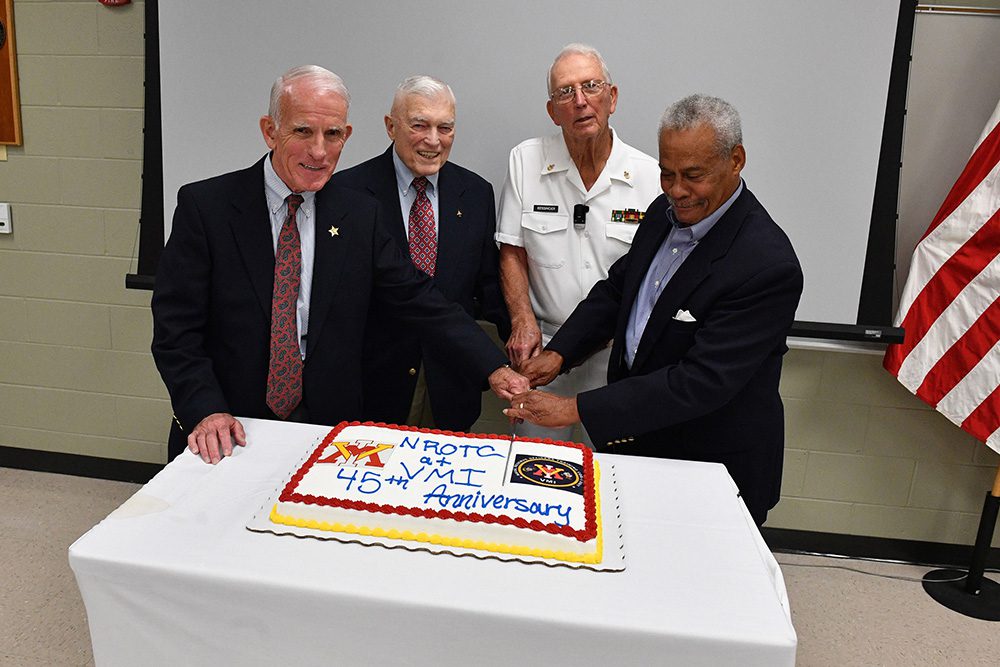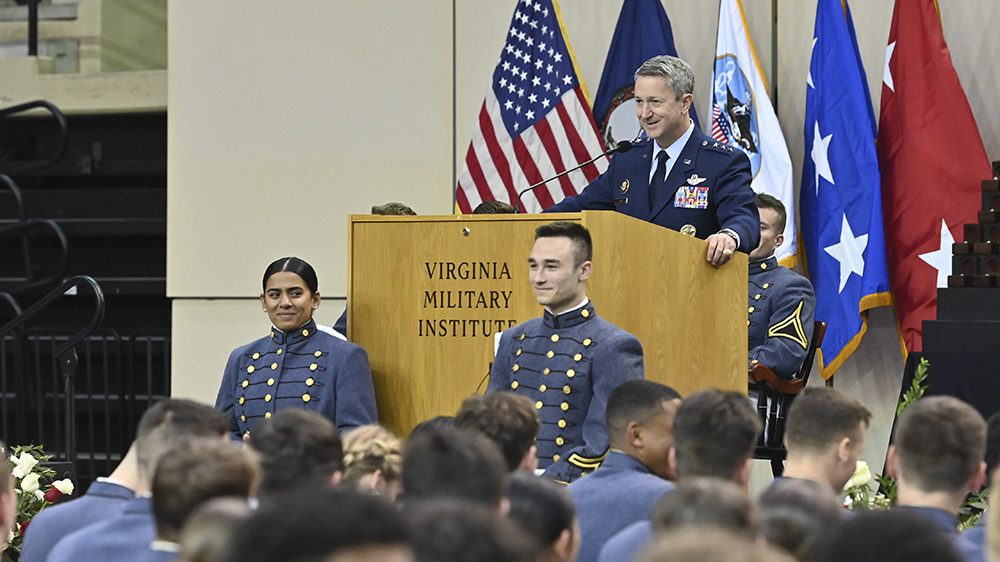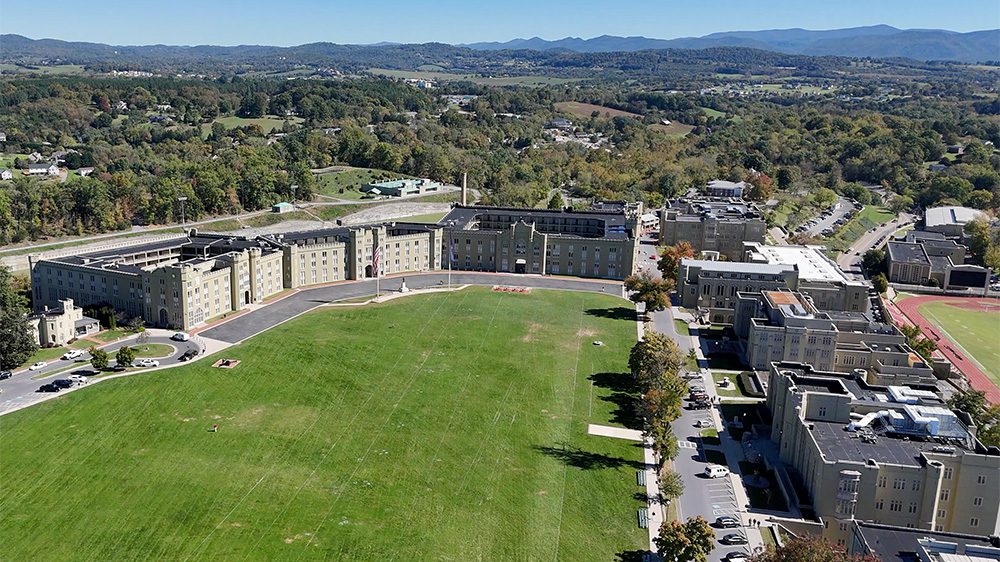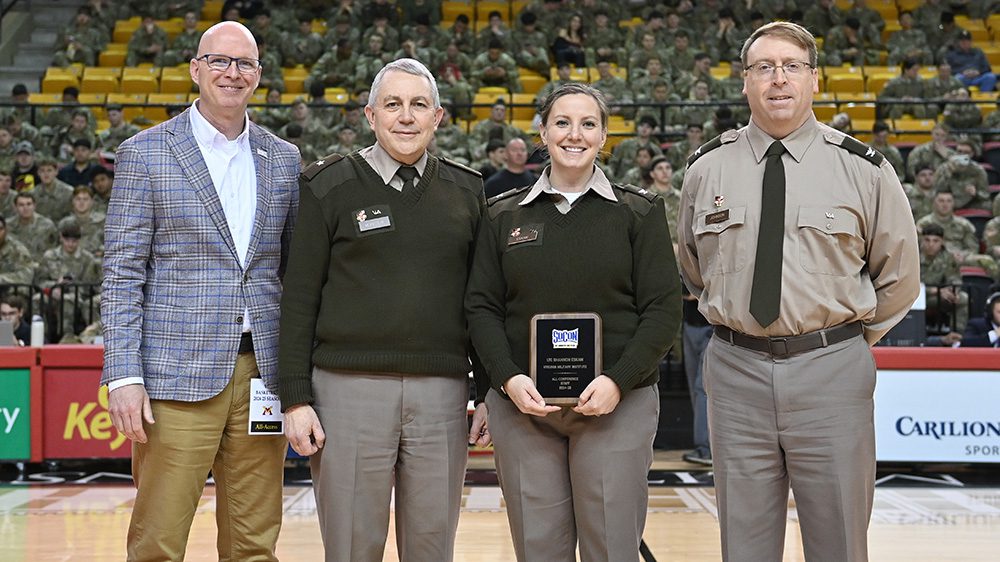VMI has had three ROTC units on post for so long that it’s sometimes hard to believe that the Army, Naval and Air Force ROTCs haven’t always been here.
But for the Naval ROTC, which celebrated its 45th anniversary with a gala Sept. 14, there are plenty of people who remember the unit’s founding and can give credit to the individuals who made it happen.
The story begins in 1973, when word came to VMI that the Naval ROTC unit at another school was shutting down. Swinging into action right away to get the unit transferred to VMI were Maj. Gen. Richard Irby ’939, then superintendent; Col. William Buchanan ’50B, then commandant of cadets; and Brig. Gen. James “Jimmy” Morgan ’45, then dean of the faculty.
Irby wrote a letter to John Warner, then secretary of the Navy, asking for permission to establish Naval ROTC at the Institute, and when that permission came, the unit was formally established July 1, 1974.
Col. Jim Williams ’66 recalled that the new unit “was stood up on a shoestring.” Williams, who was Marine officer instructor at VMI at the time, said that under normal circumstances, getting a new ROTC unit up and running would have taken two to three years, but VMI managed to do it in one year.
“We were scrambling,” he stated, with textbooks arriving just in time.
The first commanding officer of the new unit was Col. George Ripley ’52 – and one of those he recruited to work under him would go on to play a major part in the Institute’s history by serving as sergeant major to the Corps of Cadets in the 1990s.
A Marine since his enlistment in 1960, and a Vietnam War veteran, Al Hockaday was a gunnery sergeant stationed on Okinawa when one day he heard someone shout, “Hey, gunny, you got a phone call from the Pentagon!” Thinking this was likely a joke, Hockaday ignored the message – only to be told a minute later that the caller was still on the line.
He picked up the phone, barked, “Who is this?” and found himself speaking with Ripley, who was calling from the Pentagon because at the time he was serving as an aide to Warner. Little did Hockaday know back then that he’d one day call Lexington his permanent home and even run a business there, as he and his wife, ernestine, who spells her name with a lowercase “e,” ran the Shenandoah Attic and Victorian Parlour for many years.
Stood up on a shoestring or not, the Naval ROTC was well supported by the Institute from its inception. At that point, VMI had had two Marine Corps generals as superintendents – Lt. Gen. John Lejeune, who had served as commandant of the Marine Corps during the 1920s, and Lt. Gen. George R.E. Shell ’931 – so while the Naval ROTC was new to VMI, the Naval service’s tradition of leadership was not.
“Kilbourne Hall was much smaller than it is now, but even then all of the ROTC units had their own classrooms, their own studies, their own office spaces,” Hockaday explained. “VMI did a phenomenal job of preparing itself to receive the Naval ROTC unit.”
Hockaday recalled that after the first year, only four new officers were commissioned. Over the decades that followed, though, the program grew, and from 2009-19, VMI’s Naval ROTC produced nearly 500 Navy ensigns and Marine Corps second lieutenants. In spring 2020, more than 50 are expected to commission.
And the unit’s strength isn’t just in numbers. “The quality of the young men and women coming through this program is so much greater than it was 20-some odd years ago,” said Col. Craig Streeter ’91, commanding officer since 2017.
“It’s just standards of excellence across the board, whether it’s academics, physical fitness, leadership … the whole package,” Streeter continued. “It’s just extremely high standards, and I see it each and every day.”
Streeter noted that many Naval ROTC cadets who excel in ROTC also perform well in other areas of life at the Institute. “Consistently you’ll see Navy/Marines leading companies up on the hill, battalions, or even regimental companies,” he stated. “We attract high quality young men and women.”




